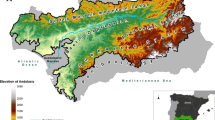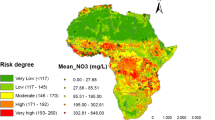Abstract
Environmental regulations often rely on limits or thresholds to indicate an acceptable pollutant load. Estimates of the Risk of Exceeding such Thresholds (RET) are often based on a single model deemed to be the best for the particular pollutant or particular case. However, if many models make different predictions but explain the data almost equally well, predictions based on a single model may omit important information contained in other models that fit almost as well as the “best” single model. More accurate assessments of RET may result if multiple models are considered. We compared performance of the single best model relative to that of an ensemble of models estimated by bagging (Bootstrap AGGregatING) using the example of soil P concentrations and the risk of exceeding environmental limits of soil P concentrations in the watershed of Lake Mendota, Wisconsin, USA. Bagging yielded significantly better predictions of the risk of exceeding a threshold level of soil P (99.6% accuracy versus 74% for single-model prediction at a 20 mg kg−1 threshold). Use of multiple model techniques can improve estimates of RET over a range of realistic thresholds in other management situations where thresholds are important including eutrophication, desertification, fisheries, and many types of pollution control.




Similar content being viewed by others
References
Aven, T. (2003). Foundations of risk analysis. New York: Wiley.
Bauer, E., & Kohavi, R. (1998). An empirical comparison of voting classification algorithms: Bagging, boosting, and variants. Machine Learning, 5, 1–38.
Bennett, E. M. (2003). Soil P concentrations across an urban–rural gradient in Dane County, Wisconsin. Environmental Management, 32, 476–488.
Breiman, L. (1996). Bagging predictors. Machine Learning, 24, 123–140.
Brock, W. A., & Durlauf, S. N. (2001). Growth empirics and reality. The World Bank Economic Review, 15, 229–272.
Carpenter, S. R. (2002). Ecological futures: Building an ecology of the long now. Ecology, 83, 2069–2083.
Carpenter, S. R., Caraco, N. F., Correll, D. L., Howarth, A. N., Sharpley, A. N., & Smith, V. H. (1998). Nonpoint pollution of surface waters with phosphorus and nitrogen. Ecological Applications, 8, 559–568.
Chan, J. C.-W., Huang, C., & DeFries, R. (2001). Enhanced algorithm performance for land cover classification from remotely sensed data using bagging and boosting. IEEE Transactions on Geoscience and Remote Sensing, 39, 693–695.
Chipman, H. A., George, E. I., & McCulloch, R. E. (1998). Extracting representative tree models from a forest, Working paper 98–07.
Clark, J. S., Carpenter, S. R., Barber, M., Collins, S., Dobson, A., Foley, J. A., et al. (2001). Ecological forecasts: An emerging imperative. Science, 293, 657–660.
Clyde, M. A., & Lee, H. K. A. (2001). Bagging and the Bayesian Bootstrap. In T. Richardson, & T. Jaakola (Eds.), Intelligence and Statistics 2001: Proceedings of the 8th International Workshop on Artificial Intelligence and Statistics (pp. 169–174). Morgan Kaufmann.
Daniel, T. C., Sharpley, A. N., Edwards, D. R., Wedepohl, R., & Lemunyon, J. L. (1994). Minimizing surface water eutrophication from agriculture by phosphorus management. Journal of Soil and Water Conservation, 49, 30–38.
De’Ath, G., & Fabricius, K. E. (2000). Classification and regression trees: A powerful yet simple technique for ecological data analysis. Ecology, 81, 3178–3192.
Efron, B., & Tibshirani, R. J. (1993). An Introduction to the Bootstrap. London, UK: Chapman & Hall.
Gburek, W. J., Sharpley, A. N., & Pionke, H. B. (1996). Identification of critical source areas for phosphorus export from agricultural catchments. In M. G. Anderson, & S. Brookes (Eds.), Advances in hillslope processes (pp. 263–282). New York: Wiley.
Gburek, W. J., Sharpley, A. N., Heathwaite, L., & Folmar, G. J. (2000). Phosphorus management at the watershed scale: a modification of the phosphorus index. Journal of Environmental Quality, 29, 130–144.
Heathwaite, L., & Shapley, A. (1999). Evaluating measures to control the impact of agricultural phosphorus on water quality. Water Science Technology, 39, 149–155.
Heathwaite, L., Sharpley, A. N., & Gburek, W. (2000). A conceptual approach for integrating phosphorus and nitrogen management at watershed scales. Journal of Environmental Quality, 29, 158–166.
Hoeting, J. A., Madigan, D., Raftery, A. E., & Volinsky, C. T. (1999). Bayesian model averaging: a tutorial (with comments by M. Clyde, David Draper and E. I. George, and a rejoinder by the authors). Statistical Science, 14, 382–417.
Kammen, M., & Hassenzahl, D. M. (1999). Should We Risk It? Princeton, NJ: Princeton University Press.
Kinzig, A., Starrett, D., Arrow, K., Aniyar, S., Bolin, B., Dasgupta, P., et al. (2003). Coping with uncertainty: a call for a new science-policy forum. Ambio, 32, 320–335.
Lamon, E. C., & Stow, C. A. (1999). Sources of variability in microcontaminant data for Lake Michigan salmonids: Statistical models and implications for trend detection. Canadian Journal of Fisheries and Aquatic Sciences, 56, 71–85 Suppl. 1.
Lemunyon, J. L., & Gilbert, R. G. (1993). The concept and need for a phosphorus assessment tool. Journal of Production Agriculture, 6, 483–486.
National Research Council (1992). Restoration of aquatic ecosystems: science, technology, and public policy. Washington, DC: National Academy Press.
National Research Council (1996). Understanding risk. Washington, DC: National Academy Press.
National Research Council (2001). Assessing the TMDL approach to water quality management. Washington, DC: National Academy Press.
Olsen, A., Sedransk, R. J., Edwards, D. R., Gotway, C. A., Liggett, W., Rathbun, S., et al. (1999). Statistical issues for monitoring ecological and natural resources in the United States. Environmental Monitoring and Assessment, 54, 1–45.
Pan, W. (1999). Shrinking classification trees for bootstrap aggregation. Pattern Recognition Letters, 20, 961–965.
Peterson, G. D., Carpenter, S. R., & Brock, W. A. (2003). Uncertainty and the management of multi-state ecosystems: An apparently rational route to collapse. Ecology, 84, 1403–1411.
Pierzynksi, G. M., & Logan, T. J. (1993). Crop, soil, and management effects on phosphorus soil test levels. Journal of Production Agriculture, 6, 513–520.
Schindler, D. W. (2006). Recent advances in the understanding and management of eutrophication. Limnology and Oceanography, 51(Part 2), 356–363.
Sharpley, A. N. (1995). Identifying sites vulnerable to phosphorus loss in agricultural runoff. Journal of Environmental Quality, 24, 947–951.
Sharpley, A. N., Chapra, S. C., Wedepohl, R., Sims, J. T., Daniel, T. C., & Reddy, K. R. (1994). Managing agricultural phosphorus for protection of surface waters: issues and option. Journal of Environmental Quality, 23, 437–451.
Sharpley, A., Foy, R. H., & Withers, P. J. A. (2000). Practical and innovative measures for the control of agricultural phosphorus losses to water: an overview. Journal of Environmental Quality, 29, 1–9.
Sharpley, A. N., & Menzel, R. G. (1987). The impact of soil and fertilizer phosphorus on the environment. Advances in Agronomy, 41, 297–324.
Smith, V. H., Joye, S. B., & Howarth, R. W. (2006). Eutrophication of freshwater and marine ecosystems. Limnology and Oceanography, 51(Part 2), 351–355.
Stow, C. A., Carpenter, S. R., Madenjian, C. P., Eby, L. A., & Jackson, L. J. (1995). Fisheries management to reduce contaminant consumption. BioScience, 46, 752–758.
U.S. Environmental Protection Agency (1996). Environmental indicators of water quality in the United States. Office of Water Criteria and Standards Division (4503F).
Walters, C. (1986). Adaptive Management of Renewable Resources. MacMillan Publishing Company.
Wilson, M. A., & Carpenter, S. R. (1999). Economic valuation of freshwater ecosystem services in the United States: 1971–1997. Ecological Applications, 9, 772–783.
Acknowledgements
This research was funded by the National Science Foundation (NSF) through the Long Term Ecological Research (LTER) program, U.S. EPA, and the Wisconsin IGERT (Integrative Graduate Education, Research, and Training) project. We thank Brian Leung and several anonymous reviewers for thoughtful comments on the manuscript.
Author information
Authors and Affiliations
Corresponding author
Rights and permissions
About this article
Cite this article
Bennett, E.M., Carpenter, S.R. & Cardille, J.A. Estimating the Risk of Exceeding Thresholds in Environmental Systems. Water Air Soil Pollut 191, 131–138 (2008). https://doi.org/10.1007/s11270-007-9612-9
Received:
Accepted:
Published:
Issue Date:
DOI: https://doi.org/10.1007/s11270-007-9612-9




